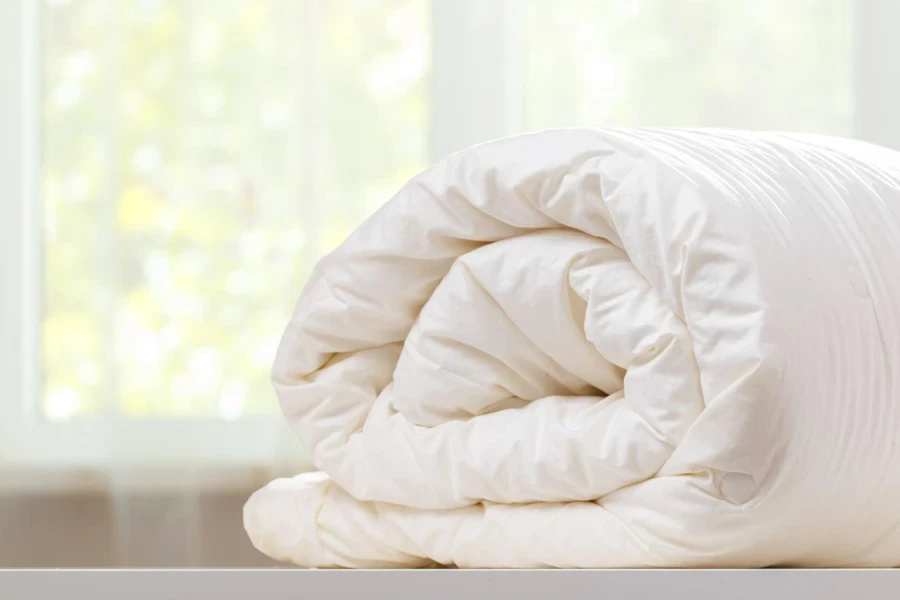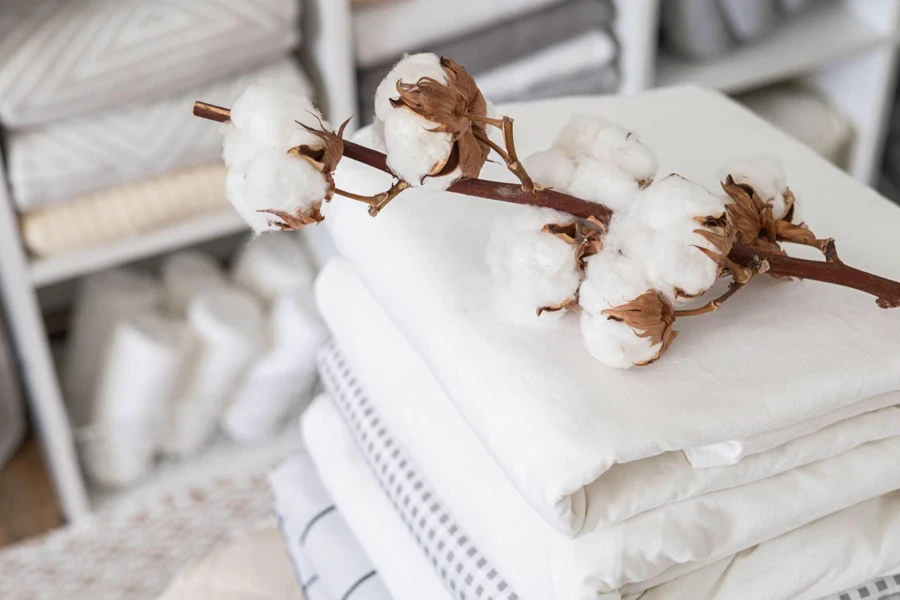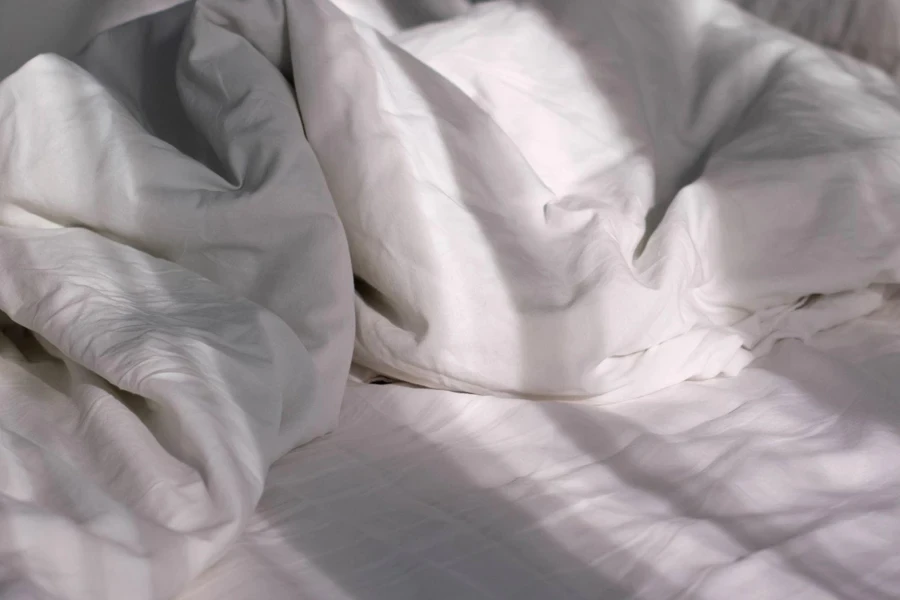In 2024, the choice of a comforter goes beyond mere bedding; it becomes a strategic decision for those in the hospitality and home goods sectors. The right comforter can significantly enhance sleep quality and overall bedroom aesthetics, factors increasingly prioritized by consumers looking for premium comfort and durability. With advancements in materials and construction, selecting the best comforter is not just about warmth but also about hypoallergenic properties, environmental impact, and long-term value. This guide aims to clarify the options and innovations that define today’s market, helping ensure selections align with both current trends and consumer expectations.
Table of Contents
1. Decoding comforter varieties
2. Pulse of the 2024 comforter market
3. Mastering the selection process
4. Champions of comfort: top comforters reviewed
Decoding comforter varieties

The selection of comforters has expanded significantly, influenced by both evolving consumer demands and innovations in textile technology. This diversity caters to varying preferences in comfort, durability, and ethical considerations, impacting the buying decisions of those in the home goods and hospitality sectors.
Fill fantasies: down versus synthetic explained. The debate between down and synthetic fills is pivotal in distinguishing comforters. Down, known for its superior warmth and lightness, is sourced from the undercoating of geese and ducks, providing unmatched insulation. However, ethical sourcing and allergy concerns have prompted a shift towards synthetic fills. These man-made fibers, such as polyester or microfiber, offer hypoallergenic properties and easier maintenance, alongside improved environmental sustainability through the use of recycled materials. The choice between down and synthetic impacts not only comfort and care but also the product’s lifecycle and consumer satisfaction.
Seasonal sensations: matching comforters to climate needs. Adapting comforter choices to seasonal needs is essential for maintaining comfort throughout the year. For cooler climates or winter months, heavier down comforters with higher fill power are preferable, as they trap more air and provide better insulation. Conversely, in warmer climates or during summer, lighter synthetic or down-alternative comforters offer sufficient warmth without leading to overheating. This adaptability to climate is a crucial factor in comforter selection, ensuring that products cater to a broad range of thermal preferences and enhancing user experience across varying geographic locations.
The range of comforters available today reflects a keen understanding of the diverse needs of today’s consumers, incorporating advanced materials and thoughtful designs that prioritize comfort, health, and environmental impact. This knowledge allows for precise product offerings that align with specific market demands and consumer lifestyles.
Pulse of the 2024 comforter market

As the comforter market evolves, a keen understanding of current innovations and consumer preferences becomes crucial for maintaining competitiveness and relevance. The industry sees a dynamic interplay of advanced technologies and shifting buyer trends, shaping both product offerings and marketing strategies.
Innovations steering today’s comforter choices: Experts currently value the comforter market at approximately US$ 6.5 billion and expect it to reach US$ 9.1 billion by 2028. They estimate this boost will happen at a 5.7% compound annual growth rate (CAGR) from 2023 to 2028. This growth is anticipated despite economic fluctuations brought about by recent global health crises.In 2024, the comforter market is driven by a surge in technological advancements that enhance both the functionality and environmental sustainability of products. New materials such as eco-friendly fibers and advanced synthetic fillers are becoming more prevalent, reflecting a growing consumer demand for sustainability without compromising on comfort. Technologies in fabric treatment that offer enhanced hypoallergenic properties and improved thermal regulation cater to a more health-conscious consumer base. These innovations not only improve the physical quality of comforters but also extend their lifespan, reducing waste and appealing to eco-savvy buyers.
Consumer pulse: preferences shaping purchases. Consumer buying behavior in the comforter market has shown a marked preference for products that align with personal lifestyle and ethical values. There is an increasing trend towards customization and personalization, with consumers seeking products that cater specifically to their individual needs, such as allergen-free materials or comforters designed for specific climate conditions. Additionally, data indicates a growing segment of consumers are willing to invest in premium products that offer added benefits, such as organic materials or smart-home compatible features. This shift underscores the importance of manufacturers and retailers adapting their strategies to focus on more targeted marketing and product development to meet the nuanced demands of today’s market.
Through these dual lenses of innovation and consumer behavior, it becomes evident that the 2024 comforter market is not just about meeting basic needs but about enriching the consumer experience with high-quality, customizable, and sustainable options. This understanding can guide industry professionals in crafting products and services that resonate with contemporary market trends and consumer expectations.
Mastering the selection process

In the realm of comforters, the criteria for selection are finely tuned to meet both consumer preferences and market demands. Understanding the nuances of fill quality, fabric characteristics, and optimal sizing are crucial. These factors are not just about comfort and aesthetics—they’re about creating a product that stands out in a competitive market.
Evaluating essentials: fill quality and power decoded. Fill quality in comforters is defined not just by the type of fill but also by its ‘fill power’. Fill power measures the loft or volume that one ounce of down can occupy, with higher numbers indicating better quality. For example, down with a fill power of 700 provides excellent insulation and lightness, making it highly sought after in premium markets. In contrast, synthetic fills like polyester or microfiber are praised for their durability and ease of care, with recent innovations enhancing their thermal properties to more closely mimic down. These options cater to different segments, such as those prioritizing easy maintenance or suffering from allergies.
The fabric factor: shells that spell luxury and comfort. The fabric of a comforter’s shell can significantly impact its market appeal. Materials like Egyptian cotton are renowned for their high thread count and luxurious feel, offering superior durability and softness. Silk, while less common, provides a uniquely smooth feel and natural temperature-regulating properties, appealing to luxury-focused consumers. On the innovation front, bamboo fabric is gaining popularity due to its softness, hypoallergenic properties, and sustainability—a key selling point for eco-conscious consumers. Each fabric type offers distinct benefits, allowing manufacturers to target specific consumer needs effectively.
Sizing up: finding the perfect fit for supreme comfort. Sizing is another critical factor in the selection of comforters. The industry standard sizes—twin, queen, and king—are designed to match mattress dimensions closely, ensuring a proper fit that enhances the bedroom’s aesthetic and functional appeal. However, the trend towards customized bedding solutions is on the rise, where comforters are tailored to specific bed sizes or customer preferences, enhancing individual comfort and satisfaction. This approach not only meets the demand for personalized products but also reduces the issues of comforters being too small or large for the bed, which can significantly impact consumer satisfaction and brand perception.
By mastering these key aspects—fill quality, fabric type, and sizing—manufacturers can develop comforters that not only meet but exceed consumer expectations. These factors are essential for creating a product that offers comfort, luxury, and practicality, thereby standing out in the crowded bedding market. This detailed approach ensures that every product released not only aligns with but also anticipates consumer trends and preferences, securing a competitive edge.
Champions of comfort: top comforters reviewed

The bedding market showcases a variety of comforter models each known for unique attributes ranging from luxurious down fills to innovative, eco-friendly alternatives. These comforters stand out not only for their features but for their ability to meet the diverse needs of today’s consumers.
Pinnacle of plush: leading down comforters and their luxe features. Leading the luxury segment, the Brooklinen All-Season Down Comforter is renowned for its 700-fill power, providing a lightweight yet warm experience. Its baffle-box construction prevents the down from shifting, ensuring even warmth distribution. In a similar vein, the Feathered Friends Bavarian 700 Down Comforter offers luxurious warmth with ethically sourced 700 fill power European white goose down, combined with a soft, long-staple cotton shell for unmatched comfort. Both comforters reflect a commitment to quality and sustainability, appealing to discerning consumers looking for premium bedding options.
The eco warriors: top-rated down-alternative comforters. In the realm of down-alternative comforters, the Buffy Cloud Comforter sets a high standard with its recycled polyester fill derived from plastic bottles and a soft eucalyptus fiber shell. It’s designed for all-season comfort, providing excellent breathability and temperature regulation. Another standout is the Utopia Bedding Quilted Comforter, which offers great value and versatility with its cozy microfiber fill and easy-care properties, making it ideal for everyday use. The Cozy Earth Bamboo Comforter also deserves mention for its luxurious bamboo-derived viscose fill, offering exceptional softness and thermal regulation, suitable for those with sensitivities to traditional down.
Innovators in insulation: comforters that regulate for all seasons. For year-round versatility, the Hotel Grand White Goose Down Comforter from Costco provides medium warmth suitable for a variety of climates, thanks to its 650 fill power and baffle-box construction that maintains an even distribution of down. The Target Casaluna Premium Down Comforter is another excellent option, balancing cost and quality with RDS-certified down, proving that ethical sourcing can be accessible at a reasonable price point.
Conclusion
The evolving landscape of the comforter market in 2024 presents a range of options tailored to enhance sleep quality through technological innovation, sustainable practices, and consumer-oriented designs. For those selecting products, the key lies in understanding the unique benefits of high fill power down comforters for luxury, down-alternative models for allergy sensitivity, and versatile all-season comforters to suit diverse climatic conditions. Prioritizing these elements will ensure offerings not only meet but exceed consumer expectations, securing a competitive edge in the dynamic home goods sector.





 Afrikaans
Afrikaans አማርኛ
አማርኛ العربية
العربية বাংলা
বাংলা Nederlands
Nederlands English
English Français
Français Deutsch
Deutsch हिन्दी
हिन्दी Bahasa Indonesia
Bahasa Indonesia Italiano
Italiano 日本語
日本語 한국어
한국어 Bahasa Melayu
Bahasa Melayu മലയാളം
മലയാളം پښتو
پښتو فارسی
فارسی Polski
Polski Português
Português Русский
Русский Español
Español Kiswahili
Kiswahili ไทย
ไทย Türkçe
Türkçe اردو
اردو Tiếng Việt
Tiếng Việt isiXhosa
isiXhosa Zulu
Zulu